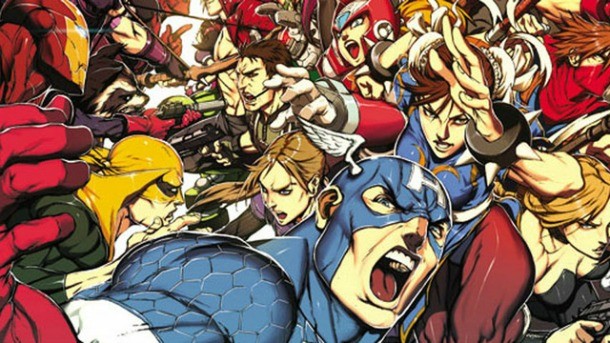Marvelous: Connecting Video Games And Comics

Marvel is one of the hottest brands in pop culture. Films like Spider-Man and The Avengers and games like Marvel vs. Capcom and Marvel Ultimate Alliance have proved that the company’s characters have a lot of appeal outside a comic book store. To better understand the fan crossover between video games and comics books, we talked with Marvel’s SVP Sales David Gabriel and SVP/GM of Marvel Digital Media Peter Phillips about some of the company’s recent initiatives like Marvel #1 and Project Gamma, which were designed to help more traditional comics appeal to the video game audience.
Tools like Marvel AR – the Augmented Reality app that provides readers with bonus information in print comics – offer a unique way for Marvel to interact with its fanbase. Have you found this useful?
Phillips: Connecting with fans is part of Marvel’s DNA, something Stan Lee pioneered in the '60s with “Stan’s Soapbox” and letter columns. Not only could fans finally get their burning questions answered by the people working on these books, but Stan pulled back the veil to show you what life was like at the Marvel offices. He would tell you about his great co-workers, the latest developments in his life, and anything else you’d want to know. It was really an early version of what we now call social media.
As Marvel’s library of stories continues to expand, how do you continue to provide new entry points for readers? Are projects like Marvel #1 the answer?
Gabriel: We live in a world of DVD box sets and video streaming, where everyone wants to start from Season 1, Episode 1, so we can’t expect fans to join with random issues in the middle of a storyline. If that happens, we make our comics accessible with recap pages at the front of every issue. But by in large we find that the first chapter of a major story or, to an even greater degree, an issue #1 will draw in more fans. That’s how we can better spotlight the great content and great creative teams.
And it’s why Marvel #1 is such an effective promotion. We’re telling the world that here are over 700 great jumping-on points, no matter at what point in our characters' histories you want to join – from Fantastic Four #1 from 1961 to recent releases under our Marvel Now! banner, such as Uncanny Avengers #1 or All-New X-Men #1.
Phillips: We’re always looking to make it easier for new readers to dive into the Marvel Universe. As an example, our all-new Marvel Unlimited program was created to bridge the gap between core fans and new enthusiasts. The program can seem daunting at first – with full access to over 13,000 comics, where do I start? To tackle that challenge, we created a new editorial program that lets our comics editors curate a monthly reading list of ten to twenty comics, all centered around a key character or theme, introducing the most exciting storylines from the Marvel Universe in a digestible way.
These kinds of programs – combined with more traditional ecommerce features like product recommendations – allow us to become that friendly voice to fans that answers the age-old question, “So what do I read next?”
You guys also recently announced Project Gamma – a service that adds a dynamic soundtrack that adapts to the pace of a reader. How will that work and where did that idea come from?
Phillips: Great stories engage the reader on multiple levels. Digital devices can do things that paper can’t. So we have the opportunity to take what was once a purely visual reading experience and explore what that might be like as a seamless, naturally integrated audio-visual experience.
Of course the greatest challenge has been that nobody has ever done something quite like this before. There have been soundtracks and audio references; there have been trans-media projects and multi-media stories, but nobody has ever created a truly audio-visual comic that simultaneously blends the score with the art and dynamically adapts to the reader’s unique reading habits, while still allowing them to retain full control of how they experience the story.
What happened to motion comics? Was that a fad?
Phillips: There are unique storytelling perspectives in this medium and we continue to explore them through our Marvel Knights Animation initiative, with some major new releases coming up, including Inhumans, Wolverine: Origin, Eternals, and more.
Do you think comics will ever go completely digital? Would there be any benefits there?
Gabriel: Last year we saw huge growth in comics sales both in print and digitally, which proves that neither medium cannibalizes the other. Both offer unique advantages – some people love the feel of a print comic, others love the convenience of digital comics – but we see no reason to stop publishing in either format in the near future. As long as we see demand, we’re going to continue the supply.
There seems to be a lot of fan crossover between video games and comic books. Why do you think that many of the same people are drawn to both of these mediums?
Gabriel: Fans love dynamic storytelling with larger-than-life characters and situations, something both comics and video games provide in spades. These are also two mediums where we’ve seen a lot of cutting-edge storytelling and moments that have defined pop culture.
Phillips: Both comics and video games provide immersive experiences, allowing you to act as third- or first-person in an exciting story that is created for you or that you can partly develop on your own. That is the type of entertainment that is seldom replicated by other means and has allure to a global audience.

Get the Game Informer Print Edition!
Explore your favorite games in premium print format, delivered to your door.
- 10 issues per year
- Only $4.80 per issue
- Full digital magazine archive access
- Since 1991









